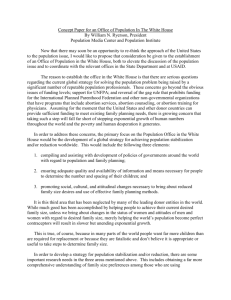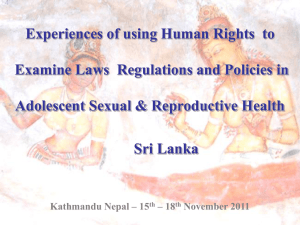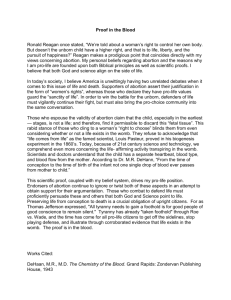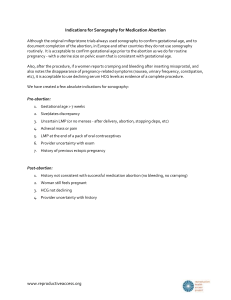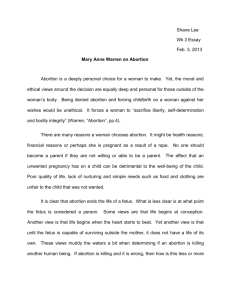PMDUP: Preventing Maternal Death from Unwanted Pregnancy
advertisement
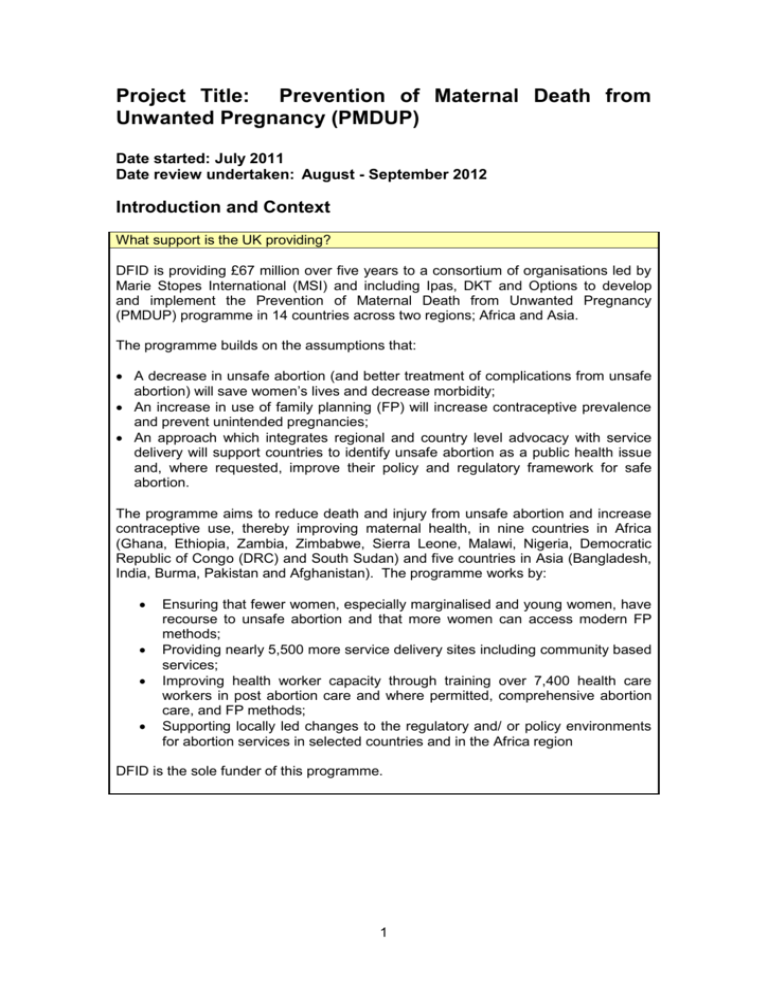
Project Title: Prevention of Maternal Death from Unwanted Pregnancy (PMDUP) Date started: July 2011 Date review undertaken: August - September 2012 Introduction and Context What support is the UK providing? DFID is providing £67 million over five years to a consortium of organisations led by Marie Stopes International (MSI) and including Ipas, DKT and Options to develop and implement the Prevention of Maternal Death from Unwanted Pregnancy (PMDUP) programme in 14 countries across two regions; Africa and Asia. The programme builds on the assumptions that: A decrease in unsafe abortion (and better treatment of complications from unsafe abortion) will save women’s lives and decrease morbidity; An increase in use of family planning (FP) will increase contraceptive prevalence and prevent unintended pregnancies; An approach which integrates regional and country level advocacy with service delivery will support countries to identify unsafe abortion as a public health issue and, where requested, improve their policy and regulatory framework for safe abortion. The programme aims to reduce death and injury from unsafe abortion and increase contraceptive use, thereby improving maternal health, in nine countries in Africa (Ghana, Ethiopia, Zambia, Zimbabwe, Sierra Leone, Malawi, Nigeria, Democratic Republic of Congo (DRC) and South Sudan) and five countries in Asia (Bangladesh, India, Burma, Pakistan and Afghanistan). The programme works by: Ensuring that fewer women, especially marginalised and young women, have recourse to unsafe abortion and that more women can access modern FP methods; Providing nearly 5,500 more service delivery sites including community based services; Improving health worker capacity through training over 7,400 health care workers in post abortion care and where permitted, comprehensive abortion care, and FP methods; Supporting locally led changes to the regulatory and/ or policy environments for abortion services in selected countries and in the Africa region DFID is the sole funder of this programme. 1 What are the expected results? The results for this programme are estimated using MSI’s Impact Estimator model which links programme service delivery volumes to outcomes. As with any model, these results will be approximate. The expected results for the five outcomes are: 19,046 maternal deaths averted in the programme period and beyond; 2.87 million unsafe abortions averted; 2.53 million unintended pregnancies prevented; 2.99 million disability adjusted life years averted; 11.1 million couple years of protection (CYPs) generated by family planning services in addition to institutionalised and sustainable attention at the national level to ensure access to safe abortion and family planning. The MSI Impact Estimator model has recently been revised to reflect latest international data. While the expected number of services to be delivered under this programme has not changed, the programme’s outcome results have been reestimated accordingly at the following values: 18,829 maternal deaths averted in the programme period and beyond; 3.17 million unsafe abortions averted; 5.66 million unintended pregnancies prevented; 4.03 million disability adjusted life years averted; 10.9 million couple years of protection (CYP) generated by family planning services. For the purposes of this first annual review the original results and corresponding logframe milestones have been used in all reporting and analysis. Subsequent reviews will use the latest impact estimator model. What is the context in which UK support is provided? DFID’s support for PMDUP will help meet Millennium Development Goal 5a (reduce maternal mortality by three quarters by 2015). Unsafe abortion is one of the major causes of maternal mortality, responsible for an estimated 13% of the annual 358,000 maternal deaths globally; an additional 8.5 million women suffer injury, illness or disability as a result of unsafe abortion. Abortion is legal (in certain circumstances) in 13 of the 14 PMDUP programme countries1. Even where abortion is illegal or allowed on restricted grounds, unsafe abortion and miscarriages will occur, and post abortion care is needed to address life threatening complications. Reducing women’s recourse to unsafe abortion and providing family planning to avoid further unintended pregnancy is therefore a public health priority. PMDUP will help achieve MDG 5 by increasing family planning use and reducing maternal mortality in each participating country. In selected countries and in line with DFID’s policy position on safe and unsafe abortion PMDUP will support locally led efforts towards policy and regulatory reform. 1 Abortion is illegal in the Democratic Republic of Congo 2 Section A: Detailed Output Scoring Output 1: Fewer women (especially marginalised and young) have recourse to unsafe abortion and fewer women have an unintended pregnancy. Output 1 score and performance description: A+ Output moderately exceeded expectation Overall good progress has been made in increasing the use of post abortion care (PAC) and, where permitted, comprehensive abortion care (CAC) as an alternative to unsafe abortion. Excellent progress has been made in the number of family planning services provided. The programme exceeded the annual milestones for three of the four output indicators and attained 91% of the milestone for the fourth indicator. There is evidence that the programme is reaching young and marginalised women (characterised as poorer clients) with 72% of Marie Stopes International’s (MSI) overall client base living on less than $2.50 per day, 27% on less than $1.25 per day and about 30% of clients across both organisations being under 25 years of age2. There is an intrinsic tension between the programme aim of reaching marginalised and young people and ambitious milestones. This may be resolved through developing a performance indicator within the programme’s logframe to measure and monitor access by these priority target groups. Progress against expected results: Indicator 1.1: Increased number of women who choose to use post abortion care, and, where permitted, comprehensive abortion care services as an alternative to unsafe abortion through MSI (excluding Burma and Malawi). Achieved 111% of the milestone but with substantial variations across the countries with five of the 12 countries (that is, excluding Malawi which does not provide any services and Burma), not achieving their milestones. Indicator 1.2: Increased number of women who choose to use post abortion care, and, where permitted, comprehensive abortion care services as an alternative to unsafe abortion through Ipas monitored sites. Achieved 119% of the milestone with variations across the range of countries. Indicator 1.3: Number of FP services provided to women through MSI/Ipas Achieved 164% of the milestone with four Asian countries contributing an additional 910,228 services over and above their first year milestones. The reasons for higher than anticipated level of services include an underestimate of demand for FP. In some contexts there was greater than anticipated demand from women for continued use of short term FP rather than switching to longer acting methods. For example in Ethiopia a change in strategy at the government's request has contributed to more effective distribution of short term methods through community based providers as opposed to the original strategy of mini-centres which support delivery of longer2 Percentage of clients aged under 20, percentage aged under 25 and percentage of clients living on under $1.25 are based on results from exit interviews in 2011 in countries where at least one channel included in the exit interview is funded by PMDUP. These countries are: Ethiopia, Ghana, Pakistan, Sierra Leone, Zimbabwe and Burma. For the percentage of clients living on under $2.50 a day, data was available for (and total average based upon) the following PMDUP countries where at least one delivery channel was funded by PMDUP: Ethiopia, Ghana, Pakistan and Sierra Leone. 3 acting methods. Indicator1.4: Percentage of post abortion / comprehensive abortion care clients who receive a Family Planning method. Not achieved. The programme achieved 91% of the milestone. The calculation of this indicator averages out the results from ten countries in which MSI is implementing PMDUP, seven of which also have data from Ipas. In these seven countries the results are weighted by the number of services provided by each agency during year one. Data on this indicator is currently not available for Burma and Malawi (no service provided), Afghanistan, South Sudan, and DRC. The average percentage of women receiving a FP method on this basis is 60% against a milestone target of 66%. Recommendations: DFID and PMDUP to explore developing a performance indicator within the programme’s logframe to measure and monitor access by poor and marginalised groups. Impact Weighting (%): 20% Revised since last Annual Review? No – this is the first annual review. Risk: High Revised since last Annual Review? No – this is the first annual review. Output 2: Increased choice of sites for post abortion care and where permitted comprehensive abortion care provided as an alternative to unsafe abortion and for modern FP services. Output 2 score and performance description: A+ Output moderately exceeded expectation The programme has exceeded both of the milestones for this output. Only two country programmes attained less than 90% of their anticipated numbers of new sites (South Sudan (MSI) and India (MSI)). In total 2,021 new sites were added in year one, 24% of which (482) were Ipas intervention sites in the public health sector. The programme has thus increased the choice for clients seeking family planning, post abortion care and, where permitted, comprehensive abortion care. Progress against expected results: Indicator 2.1: Increased number of MSI sites (static clinics, etc.) enabling women to choose post abortion care, and where permitted comprehensive abortion care services as an alternative to unsafe abortion and modern methods of FP. Achieved 113% of milestone with the majority of countries being within 20% of their original targets. A revised strategy in Ethiopia led to the initial milestones being substantially exceeded; expanded outreach has also been successful in Ghana. Elsewhere, for example in India, changes in the process for licensing clinics has meant that progress has been slower than anticipated, however the programme is continuing through other delivery channels to ensure that overall delivery is not 4 compromised. Indicator 2.2: Increased number of Ipas intervention sites enabling women to choose post abortion care, and where permitted comprehensive abortion care services as an alternative to unsafe abortion and modern methods of FP Achieved 144% of milestone. Opening facilities ahead of schedule in Bangladesh, Nigeria, Ethiopia and India has contributed to the higher than anticipated achievement in year one. Recommendations: There are no recommendations specific to this output. Impact Weighting (%): 20% Revised since last Annual Review? No – this is the first annual review. Risk: Medium Revised since last Annual Review? No – this is the first annual review. Output 3: Improved capacity of the health sector which enables women to access post abortion care, and where permitted comprehensive abortion care services provided as an alternative to unsafe abortion and to choose modern methods of FP Output 3 score and performance description: A+ Output moderately exceeded expectation All three indicator milestones have been achieved and the programme has contributed to improved capacity in the health sector through the training of 2,158 health workers during the first year of the programme and through helping to ensure high quality through the monitoring of quality standards. Quality assessments were undertaken in the public health facilities in four of the Ipas supported countries and ten MSI programmes (outreach and static centres). Progress against expected results: Indicator 3.1: Number of health workers trained enabling women to choose post abortion care, and where permitted comprehensive abortion care services provided as an alternative to unsafe abortion and/ or modern methods of FP. Achieved 137% of milestone: a total of 2,158 health workers were trained. Milestones were achieved in all countries except Afghanistan (achieved 91%), DRC (89%) and MSI India (11%). In India there were delays in receiving government accreditation of a training centre. MSI in Bangladesh, Ethiopia and Nigeria opted to train more than the anticipated numbers of health workers in year one (and set up more sites). In addition, higher than anticipated performance by Ipas in Bangladesh and Nigeria has contributed to the attainment of the milestone. Indicator 3.2: Percentage of Ipas facilities where manual vacuum aspiration and/or medical abortion availability, where permitted, meets the quality standard (as appropriate per setting). Achieved 148% of milestone. This indicator is calculated through the averaging of data from four countries (Nigeria, Zambia, Ethiopia and Bangladesh). Bangladesh attained 100% of the standards at all centres. Data is not collected in three 5 countries; Ghana, Pakistan and India. Indicator 3.3: Percentage of facilities reaching minimum service quality standards. Achieved 117% of milestone. The calculation is an average of all MSI and Ipas sites which have submitted data and where MSI have undertaken their quality assessment process. A total of 10 countries have been considered, seven of which have no Ipas data. The average percentage of facilities attaining the minimum standard for year one is 88%, two countries were below 70%, four were in the bracket 80-89% and five scored over 90%. Recommendations: PMDUP to ensure that quality standards and quality assessment processes are in place, in particular for social franchisees, and that these standards and processes are communicated to relevant stakeholders. Impact Weighting (%): 20% Revised since last Annual Review? No – this is the first annual review. Risk: Medium Revised since last Annual Review? No – this is the first annual review. Output 4: Locally led changes to the national and regional environment on safe abortion and modern FP services Output 4 score and performance description: A+ Output moderately exceeded expectation. There is good evidence that the programme has achieved the aim of supporting locally led changes through the provision of capacity building support to 88 organisations in nine countries and to collaborating partners and those involved in the regional work in Africa. The programme has supported and/or facilitated ten changes in policy or regulations during its first year. The country reviews in Pakistan and Sierra Leone gave the opportunity to discuss the impact of the PMDUP programme under this output and the feedback was generally very positive: representatives from the organisations being supported indicated that the support facilitated locally led change and that Ipas’s expertise and access to global evidence and learning had generally led to more wide-ranging changes. Progress against expected results: Indicator 4.1: Locally led changes in policy, and regulatory environment that reduce restrictions in access to safe abortion and to FP services and supplies. Achieved. The actual result exceeded the target (of seven changes in five countries and two regional changes in Africa) by an additional three changes and in an additional country: that is, 10 changes in six countries and two regional changes in total. Indicator 4.2: Number of local and regional organisations/networks whose capacity is 6 built to support locally led advocacy and community efforts to reduce recourse to unsafe abortion and increase access to modern FP. Achieved 101% of milestone. The programme worked with a total of 88 local and regional organisations and networks. The majority of the country programmes achieved their targets and all came within 20% of doing so. The reviews in Pakistan and Sierra Leone reviewed the effectiveness of the capacity building and the management of this aspect of the programme through discussion with representatives from organisations/networks involved in the programme. In both instances the representatives indicated that the capacity building programmes and support received is appropriate and valuable. Recommendations: There are no specific recommendations however it is noted that the complexity of the indicator may in future lead to problems with clarifying the level of achievement should one or two of the three variables not be met. Impact Weighting (%): 30% Revised since last Annual Review? No – this is the first annual review. Risk: Medium Revised since last Annual Review? No – this is the first annual review. Output 5: Evidence-based practice and innovations shared to increase women’s choice and access to post abortion care and where permitted comprehensive abortion care and modern FP Output 5 score and performance description: A+ Output moderately exceeded expectation. The programme exceeded the milestone whilst spending 40% of the allocated budget. This is due to payments for some activities for year two outputs slipping into year two of the programme. Progress against expected results: Indicator 5.1: Examples of evidence-based practices disseminated to influence programmatic decision making e.g. peer reviewed articles, workshops, case studies, tools Achieved. A total of 15 evidence-based practices were disseminated by the programme in year one. Recommendations: None under this output. Impact Weighting (%): 10% Revised since last Annual Review? No – this is the first annual review. Risk: Low Revised since last Annual Review? No – this is the first annual review. 7 1. Progress and results 1.1 Has the logframe been updated since last review? Yes The model for estimating outcome level indicators has been updated to reflect latest international data – see Introduction and Context section. 1.2 Overall Output Score and Description: A+ The PMDUP programme has been very successful in its first year and exceeded the almost all of its milestones. In some areas the performance has been exceptional and close to being scored at A++, however there is variation of achievement across countries. Milestones may have been set cautiously in some programme areas to reflect the uncertainties of the new programme, of the new partnership and of working in new locations. This review has assessed the programme design and implementation as generally strong and internal risks appear to be well monitored and managed. The flexibility of the design appears to contribute to the programme’s success. There is scope better to define the expectation around access for marginalised and young women. The risk of changes in the operating environment exists in all country contexts with some changes unpredictable. The programme benefits from substantial experience within both main partners and their respective connections and is well placed to respond to change. It is possible that changes may result in the programme failing to meet its outcomes in some countries. Notwithstanding some minor issues, the partnership between MSI, Ipas and DKT appears to be effective and contributing positively to programme performance. There is scope at country level to define and improve the effectiveness of the partnership between MSI and Ipas. 1.2 Direct feedback from beneficiaries As part of this annual review, in-depth reviews in Pakistan and Sierra Leone provided some scope to discuss the programme with beneficiaries however the opportunities were limited by the time available. The actual number of women who provided feedback was not adequate to make the information meaningful in the context of the annual review however the feedback was very positive. Women using a clinic in Sierra Leone stated that the access to post abortion care was a vital and much valued service particularly for young women who are at the highest risk of unintended pregnancy and recourse to unsafe abortion. As a matter of routine, MSI undertakes client satisfaction exit surveys at its clinics. Median satisfaction scores across 10 dimensions of service quality were in excess of 80% with the lowest score for waiting times and the highest score for service prices. 8 1.4 Summary of overall progress In its first year of operation, the PMDUP programme has achieved, and in most instances surpassed, output and outcome milestones for year one. Specific modelled results include3: 2,305 maternal deaths were averted, just under the target of 2,350 for year one and a shortfall of 2% against the year one milestone. 352,696 unsafe abortions and 390,810 unintended pregnancies were prevented, surpassing annual milestones by 6% and 10% respectively. 1,712,513 couple years of protection were achieved, surpassing the year one milestone by 10%. Although overall outcome and outputs have been achieved and exceeded under PMDUP, the results from the Africa region have been lower than projected in year one and Asia has exceeded year one milestones. In Africa maternal deaths averted were 63% of target (significantly up from 17% at six months) while unintended pregnancies prevented were 88% of target (up from 25% at six months). This is mainly because of operational delays in conflict-affected countries and the need to recall an inferior misoprostol product. However, results in the last six months of year one have significantly improved compared to the first six months. This faster pace in Africa is expected to continue in year two, given the solid foundation that has been established. This foundation includes a wide range of health facilities and trained health providers with increasing commitment and capacity to provide family planning, post abortion care, and where permitted, comprehensive abortion care services. This foundation was achieved, in part, through adaptive programming by Marie Stopes International and Ipas, in response to evolving environments. 1.5 Key challenges The key challenges to the achievement of overall results identified through the annual review process are: Changes in the operational context: there have been some changes in the operating environments in some PMDUP countries since the programme design. These include instances of worsening security, for example in Pakistan and Nigeria and some contexts where price inflation has had an impact, such as South Sudan. PMDUP programme managers have responded flexibly by adjusting implementing strategies to minimise impact on service delivery. For example, in Nigeria PMDUP has relocated some activities. In South Sudan, higher than expected costs and deteriorating security has required an uplift to the budget, drawing on the programme contingency budget. Changes in the policy context: in some countries the policy environment has become less favourable for the PMDUP programme. For example changes in Zambia, has delayed implementation. Safeguarding favourable policy whilst supporting policy development in more restrictive settings has required constant attention. Weak health systems: PMDUP has been designed to respond to prevailing country operating contexts and some health system impediments can only be accommodated, rather than resolved, especially in respect of PMDUP’s work in and with the public sector. Issues faced range from a lack of Human Resources for Health (HRH) and their mal-distribution to commodity stock outs, equipment shortages and weak data collection related to poor Health Management Information Systems (HMIS). Challenges also exist in the private sector in relation to basic operating conditions and capacities. Various mitigation measures have been applied 3 Estimates based on Impact Estimator 1.2 (the published log frame) 9 but have not completely addressed low achievement in some countries in year one. Progress, especially in Africa, will be closely monitored in year two and implementation strategies adjusted as needed. Access to quality inputs: Quality input issues range from training to the quality of commodities. For example, the training for Afghanistan providers had to be relocated to India where trainers and case load were available; an initial batch of trainees were trained as trainers-of-trainers and subsequently were able to provide the training to a number of providers in Afghanistan. In Sierra Leone, misoprostol had to be withdrawn after inferior quality was detected by MSI delaying programme implementation. 1.6 Annual Outcome Assessment Good progress has been made towards attainment of year one outcome level indicators indicating significant steps have been made to in reducing and preventing deaths as a result of unintended pregnancy. The table below provides a summary of the achievements against the year one milestones. The programme has achieved all indicators except the number of maternal deaths averted which was missed by only 2%. As indicated in the table below the Africa region has generally not attained its anticipated milestones and the achievement of the programme targets is underpinned by higher than expected levels of performance in Asia. The performance in Africa in the second six months of year one was a marked improvement over the first six months and it is expected that this positive trend will continue. O1. Maternal deaths 2,305 maternal deaths averted. Achieved 98% of averted the milestone with significant variation between the regions: Asia achieved 122% and Africa 63% of their milestones respectively. O2. Number of unsafe 352,696 unsafe abortions averted. Achieved 100%: abortions averted Asia 129% and Africa 65%. O3. Number of unintended pregnancies prevented 390,810 unintended pregnancies averted. Achieved 110%: Asia 115% and Africa 88%. O4. DALYs averted 397,230 DALYs have been averted. Achieved 105%: Asia 117% and Africa 76%. O5. Evidence of systemwide commitment to ensure access to CAC/PAC/FP that is institutionalised and sustainable There is evidence of a growing commitment across both regions. O6. Couple Years of Protection generated by FP services 1,712,513 CYPs generated. Achieved 110%: Asia 113% and Africa 84%. 10 2. Costs and timescale 2.1 Is the project on-track against financial forecasts: Yes Overall the programme has spent 86% of the year one forecast with outputs one, two and three being within 5% of the forecast (under the forecast). Expenditure on output five is relatively low at 40% of forecast although all planned activities have been undertaken and milestones reached due to the timing of payments which contribute to year two outputs. 2.2 Key cost drivers During the first year, £11 million was spent; out of this total 55% was spent on delivering services (commodities, supplies and labour) and the balance on system support and programme management (supervision, training of personnel, health education, monitoring and evaluation, advocacy, building and maintaining information systems and commodity supply systems). Both categories of expenditure include MSI-Ipas headquarter costs, which includes all systems development, technical support including quality management and supervision which are essential for programme performance. These costs were on average around 25% of total expenditures in the first year. This proportion includes programme design costs and will diminish as a proportion of total budget over time. 2.3 Is the project on-track against original timescale: Yes Despite some delays and on-going operational issues in some country programmes the programme as a whole is on track at the end of year one. 3. Evidence and Evaluation 3.1 Assess any changes in evidence and implications for the project. There have been no significant changes in the evidence on which the theory of change is based. In 2012 the World Health Organization (WHO) published the second edition of ‘Safe Abortion: technical and policy guidance for health systems’ which will inform practice in PMDUP. 3.2 Where an evaluation is planned what progress has been made? DFID has contracted a consortium led by London School of Health and Tropical Medicine (LSHTM) concurrently to undertake an evaluation of PMDUP (including an impact evaluation) this is separate to the main PMDUP programme. The evaluation design is currently being finalised. 11 4. Risk 4.1 Output Risk Rating: Medium The programme operates a risk matrix to accommodate the varying risks across the fourteen counties as below. During year one Nigeria has been re-categorised as ‘high probability’ (from a previous categorisation of medium) to reflect changes in the security situation and Burma has been re-categorised as ‘medium probability’ from a previous categorisation of ‘high probability’ on the risk matrix. IMPACT PROBABILITY LOW LOW MEDIUM HIGH Zimbabwe Malawi Afghanistan MEDIUM Zambia Ghana Sierra Leone Burma South Sudan DRC HIGH Bangladesh Ethiopia India Pakistan Nigeria 4.2 Assessment of the risk level The PMDUP programme has undertaken a comprehensive assessment of potential risks identified at the design stage, their probability and potential impact. A mitigation strategy exists for each risk. Mitigation strategies have been strengthened where needed. These appear to be well considered and appropriate to the level and probability of the identified risk. The overall risk level of the project is medium. 4.3 Risk of funds not being used as intended There is very limited risk of funds not being used as intended as all implementing partners make payments in accordance with generally acceptable accounting procedures and DFID rules and regulations as outlined in their contracts. Implementing partners have robust financial policies and procedures in place to ensure that funds are used as intended. This includes an annual internal and/or external audit programme with certification submitted to DFID in line with contractual requirements. A due diligence check of Marie Stopes International was carried out for DFID prior to implementation and outstanding issues were addressed. 4.4 Climate and Environment Risk The PMDUP Business Case identified the potential climate change score for this programme as ‘C’ - challenge. The relevant areas identified in the Business Case include: Risks of the project: increased medical waste, increased transport (air travel and road transport for service delivery and supervision). Risks to the project: conflict or humanitarian situations Benefits and opportunities: decreases in fertility resulting from this project could have an impact on population growth which would slow down the increase in emission and environmental degradation. but with no specific action required. MSI and Ipas’s quality assurance systems ensure safe disposal of medical waste. On transport, PMDUP partners operate systems to minimise air and road travel and MSI has introduced a new fleet management systems to make most effective and efficient use of vehicles. 12 5. Value for Money (VfM) 5.1 Performance on VfM measures With regard to the VfM indicators for the programme’s outcomes year one performance compares favourably with the anticipated results which compare the results to the original Business Case calculations and a revision of these to 2012 prices. The cost per DALY averted of £19.78 compared to the anticipated cost of £22.41 (adjusted to 2012 prices) indicates that the programme is highly cost effective. To contextualise this, WHO state that an intervention with a cost-effectiveness ratio less than the national GDP per capita for each DALY averted should be considered highly cost–effective and ratios of two and three times the GDP per capita should be considered cost-effective. The average cost per DALY for the PMDUP programme ranges from £10 to £110 across the four type of countries given that the GDP per capita in DRC, one of the poorest of the countries in the programme, is US$182 (£114.6) it is clear that value for money is being achieved. The value for money appraisal undertaken as part of the annual review estimates the cost per CYP of £6.05 (at 2012 prices). The latter compares favourably with the original estimate, in the business case, of £3.59 - £6.49 (at 2010 prices with the variation depending on whether the total budget includes public sector costs, central costs or just service delivery). As expected, Africa shows significantly higher unit cost per generating CYP than Asia, partly explained by the higher cost base and lower service volumes. The first year of implementation has seen a number of unanticipated changes to the delivery of the programme including delayed starts in some programmes and revised strategies in others which have had an impact on both the costs and the number of services delivered. It is too early to judge whether or not the programme is on track to maximise value for money over the full five years. As the programme becomes more established there will be potential for greater economies of scale. 5.2 Commercial Improvement and Value for Money (VfM) The programme was tendered as a ‘design and build’ contract, through an open international OJEU bidding process. To maximise the number of potential suppliers and the effectiveness of the programme, neither the countries nor technologies and strategies were stipulated in advance. Given that the issues that PMDUP addresses are a specialist area, it was likely that consortia would form. Two full bids from consortia were received and selection made on the quality and track record of the organisations and personnel and their capacity to fulfil the TORs, in particular to go to scale rapidly and ensure high quality service delivery. Attention was paid to VfM at each stage in the tendering and contracting process, while recognising that unit costs will vary in each PMDUP country. Unit costs in Asia are markedly lower in Asia than in Africa, and in fragile and conflict affected countries where infrastructure is poor and few existing services on which to build. Because of the strategic importance of improved service delivery across a range of country types, the programme is not preferentially allocating resources to the lowest cost settings. The contract is being managed on a performance basis with quarterly payments partly linked to performance on three key measures of progress with outputs: FP service delivered, number of health workers trained and number of new sites added. The contractor partners are driving improvements in VfM by deploying effective technical assistance from HQ to improve technical, financial, quality and monitoring 13 systems in country programme, to strengthen business models. In addition MSI has introduced systems and initiatives to improve VfM at organisational and country levels. These include specific work on: procurement and supply chains, vehicle fleet management and VfM through its sub-contracts. Ipas also is working to improve VfM for procurement and to maximise the programmatic impact of any international travel. There are a number of examples of practices which will be contributing to the overall VfM of the programme; for example sharing vehicles when attending meetings, undertaking joint supervisory visits, sharing training materials, best practice guides and expertise and contacts to reduce the time and resources required to create new documents and relationships. 5.3 Role of project partners At the programme level the MSI and Ipas head office teams have established effective management arrangements for PMDUP which are responsive to the programme and each other’s requirements and needs. The level of in-country collaboration between the two main implementing agencies is variable and to a large part depends on the work being undertaken and the individuals involved. There is recognition of some duplication of effort and failure to maximise opportunities to work with higher levels of synergy and saving. It is a recommendation of the review that there is scope to provide further clarity on the expectations of the relationship between MSI and Ipas within countries and to identify strategies to support the country teams in achieving this; these may include sharing success stories and mandating the health advisers to facilitate improved relations where necessary. 5.4 Does the project still represent Value for Money : Yes – see data in 5.1 above 5.5 If not, what action will you take? N/A 6. Conditionality 6.1 Update on specific conditions Not applicable to PMDUP 7. Conclusions and actions The PMDUP programme has been very successful in its first year and exceeded the vast majority of its milestones. The milestones may have been set cautiously in some areas to reflect the uncertainties of the new programme, of the new partnership and of working in new areas. In other areas, particularly in Africa, the milestones were possibly over optimistic in their estimation of the time it would take to set up operations. Programme design and implementation is generally strong and internal risks are well-monitored and managed. Flexibility in relation to the implementation strategies contributes to the programme’s strong performance. The risk of changes in the external environment exists in each country and mostly cannot be predicted. The programme benefits from substantial experience within both main partners and their respective connections and is well placed to respond to 14 change however it is possible that some changes may result in the programme failing to meet its outcomes. Notwithstanding some minor issues, the partnership between MSI, Ipas (and DKT) appears to be effective and contributing positively to the programme. There is scope at country level to define and improve the impact and effectiveness of the partnership between MSI and Ipas. Recommendations: 1. DFID to undertake a robust review of the trajectory of programme performance at the end of the first quarter of year two, in particular in Africa around any area of underperformance. 2. DFID and PMDUP to explore developing a performance indicator within the programme’s logframe to monitor access by marginalised and young women. 3. DFID to review milestones annually to ensure that they are relevant to the programme’s implementation in country, especially where changes to country strategy have been made, and that the consolidated milestones reflect the programme as a whole. 4. DFID to consider the annual review recommendations on the operation of the Key Performance Indicator system for quarterly payment of invoices to ensure that the basis for payment is robust. 5. DFID to consider acceleration of results or additional funding to support expansion where there is a strong case. 6. MSI and Ipas to support their respective country teams to maximise the benefits of joint working. 7. DFID and MSI to consider improving the flexibility of funds allocated to Ipas policy related activities to allow them to respond rapidly to unexpected crises and opportunities. There may be need in due course to consider if there are sufficient funds within the programme allocated to work related to policy. 8. MSI, Ipas and DKT to develop a transition strategy to meet DFID’s policy on reproductive health commodities. 8. Review Process The annual review was undertaken by a team of contracted consultants comprising a UK based reproductive health specialist (team leader) who undertook the in-depth review in Sierra Leone, a Pakistan-based national consultant who undertook the indepth review in Pakistan and a health economist who undertook the value for money appraisal. The process for the global review was as follows: Review of PMDUP’s first annual review and relevant programme reports Interviews with representatives from MSI, Ipas and DKT at country level (a total of 13 MSI countries, all seven Ipas countries and the Ipas regional policy team). 15 Interviews with DFID health advisers in 12 of the 13 countries in which they are present and with the senior regional health adviser providing support to the Afghanistan programme. Relevant management, programme, financial and monitoring, research and evaluation staff at MSI and Ipas’s head and regional offices. Review of programme data including data tracking in two countries For the in-depth reviews additional meetings were held with key stakeholders including, Ministry of Health staff (in Sierra Leone only). Meetings with local district authorities, civil society and other organisations/networks being supported by the PMDUP programme. In addition there were visits to government health facilities and outreach programmes, meetings with health workers and with beneficiaries through community meetings, focus groups discussions and exit interviews at health facilities. Findings were discussed with DFID’s PMDUP Programme Board and MSI on 18th September 2012. 16
